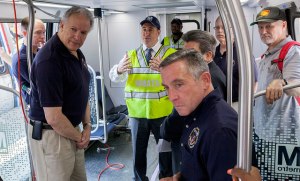By Mark Rosekind, PhD
 Summer in Washington and the city’s bustling Metrorail transit system is packed with tourists, interns, and the usual daily commuters including those I work with at the NTSB. It seems a fitting time to focus on rail transit safety, one of the agency’s Most Wanted List items of national transportation safety priorities.
Summer in Washington and the city’s bustling Metrorail transit system is packed with tourists, interns, and the usual daily commuters including those I work with at the NTSB. It seems a fitting time to focus on rail transit safety, one of the agency’s Most Wanted List items of national transportation safety priorities.
Last week, I spoke to a gathering of the American Public Transportation Association’s (APTA) transit board members on what the NTSB does and how its recommendations enhance the traveling public’s safety.
I used the opportunity to highlight a success story from the agency’s own hometown, where a horrible tragedy and the NTSB’s Recommendations from that tragedy have helped make the nation’s second busiest rapid transit system, the Washington Metropolitan Area Transit Authority’s (WMATA) “Metro,” safer than ever. To quote former NTSB Chairman Deborah Hersman, “[It] has gone from worst to first” in safety.
The NTSB just recently closed three Recommendations issued in the aftermath of the 2009 Fort Totten Metro collision in which a lead rail car struck a stopped train. Nine people were killed and 52 were injured. Metro has worked hard to improve from that sad day and there is more good news. Of the 16 new Recommendations that came from that crash, the transit authority is setting its sights to close the remaining ones involing longer-term projects – such as replacement of Metro’s entire 1000-series fleet with new, safer 7000-series railcars. The first 7000-series trains are expected to enter service late this year and I recently rode one still under trials.
It was an eye-opening experience. These new railcars will provide Metro riders with some of the latest innovations in protection and safety. They are designed for greater crashworthiness and increased durability with advancements in technology that will help prevent future tragedies like the Ft. Totten crash.
The NTSB has made a total of 29 safety Recommendations to WMATA over the years and only five remain to be closed including the 7000-series railcar replacement. This is a noteworthy achievement and reflects the benefits of having a willing, conscientious transportation operator that can take the NTSB’s Recommendations and use them as a roadmap for greater safety. In the five years since Fort Totten, Metro has improved safety on multiple fronts…railcars…infrastructure…organizational culture. It is good to see and more remains to be done, because we never want to have another crash like Ft. Totten occur, but also because this is the transit system that serves all Americans in the nation’s capital, visitors, tourists, interns, and the general public. It must serve as a model for the country and the world. That begins with safety.
 Mark Rosekind, Ph.D., is a Member of the National Transportation Safety Board. He is a frequent contributor to the NTSB blog.
Mark Rosekind, Ph.D., is a Member of the National Transportation Safety Board. He is a frequent contributor to the NTSB blog.



 trolled flight into the concrete face of a beachfront condominium, before they finally fell onto the roof of a parked car.
trolled flight into the concrete face of a beachfront condominium, before they finally fell onto the roof of a parked car.